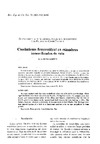Identificador persistente para citar o vincular este elemento:
https://accedacris.ulpgc.es/jspui/handle/10553/74050
| Campo DC | Valor | idioma |
|---|---|---|
| dc.contributor.author | Garcés Martín, Gerardo | en_US |
| dc.date.accessioned | 2020-08-09T17:48:16Z | - |
| dc.date.available | 2020-08-09T17:48:16Z | - |
| dc.date.issued | 1986 | en_US |
| dc.identifier.issn | 0304-5056 | en_US |
| dc.identifier.other | Dialnet | - |
| dc.identifier.uri | https://accedacris.ulpgc.es/handle/10553/74050 | - |
| dc.description.abstract | Se realiza un trabajo experimental con ratas en crecimiento a las que se inmovilizó el miembro posterior derecho en posición funcional. Semanalmente, durante cuatro,· los animales fueron sacrificados midiéndoseles a continuación los fémures y las tibias comprobándose que el crecimiento en éstas fue mayor en las inmovilizadas que en los controles (p o. 001 ). Los fémures, sin embargo, mostraron longitudes muy similares en ambos miembros. Se concluye que la inmovilización de un miembro en posición funcional no es perjudicial para el crecimiento óseo. | en_US |
| dc.description.abstract | An experimental study has been carried out using rats stills in the growth stage, whose right hindlimbs have been immobilized. Weekly, during four weeks, the animals were destroyed and measurements taken of the tibias and femurs, establishing that the rate of tibialis growth was higher in the immobilized limb than in the free limb (p. o. 001). The femurs, however, showed a similarity of measurement in both limbs. Our findings show that immobilization of a limb in a functional position is in no way prejudicial to bone growth. | en_US |
| dc.language | spa | en_US |
| dc.relation.ispartof | Revista española de cirugía osteoarticular | en_US |
| dc.source | Revista española de cirugía osteoarticular [ISSN 0304-5056], v. 21 (122), p. 105-108 | en_US |
| dc.subject | 310910 Cirugía | en_US |
| dc.subject.other | Crecimiento óseo | en_US |
| dc.subject.other | Inmovilización | en_US |
| dc.subject.other | Rata | en_US |
| dc.subject.other | Bone growth | en_US |
| dc.subject.other | Rat | en_US |
| dc.title | Crecimiento femorotibial en miembros inmovilizados de rata | en_US |
| dc.type | info:eu-repo/semantics/Article | en_US |
| dc.type | Article | en_US |
| dc.identifier.url | http://dialnet.unirioja.es/servlet/articulo?codigo=5678337 | - |
| dc.description.lastpage | 108 | en_US |
| dc.identifier.issue | 122 | - |
| dc.description.firstpage | 105 | en_US |
| dc.relation.volume | 21 | en_US |
| dc.investigacion | Ciencias de la Salud | en_US |
| dc.type2 | Artículo | en_US |
| dc.contributor.authordialnetid | 1615937 | - |
| dc.identifier.dialnet | 5678337ARTREV | - |
| dc.utils.revision | Sí | en_US |
| dc.identifier.ulpgc | Sí | es |
| item.fulltext | Con texto completo | - |
| item.grantfulltext | open | - |
| crisitem.author.dept | GIR Biomaterials and Biomechanics Research Group | - |
| crisitem.author.dept | Departamento de Ciencias Médicas y Quirúrgicas | - |
| crisitem.author.orcid | 0000-0003-4494-9077 | - |
| crisitem.author.parentorg | Departamento de Ingeniería Mecánica | - |
| crisitem.author.fullName | Garcés Martín, Gerardo | - |
| Colección: | Artículos | |
Visitas
112
actualizado el 01-feb-2025
Descargas
167
actualizado el 01-feb-2025
Google ScholarTM
Verifica
Comparte
Exporta metadatos
Los elementos en ULPGC accedaCRIS están protegidos por derechos de autor con todos los derechos reservados, a menos que se indique lo contrario.
